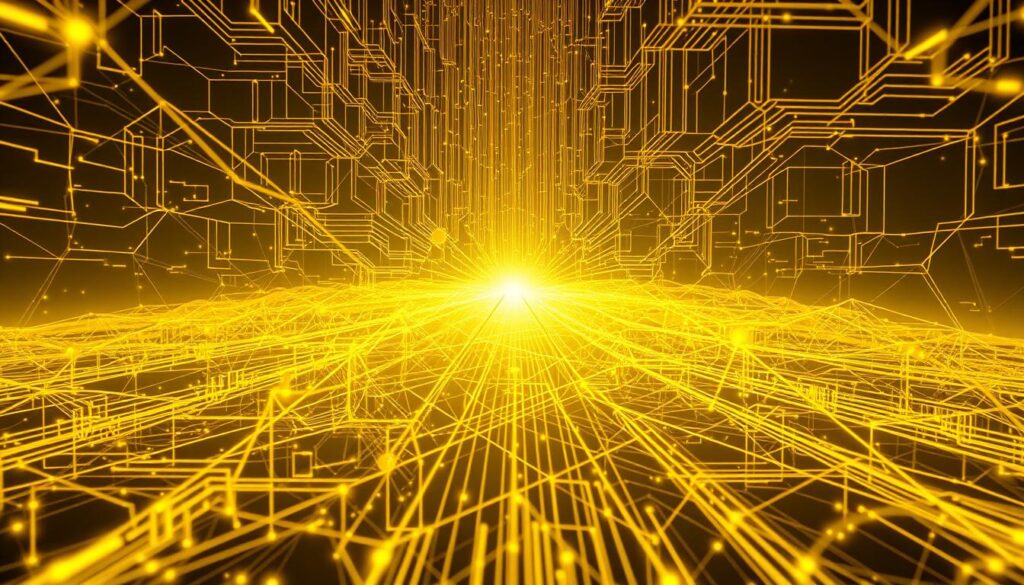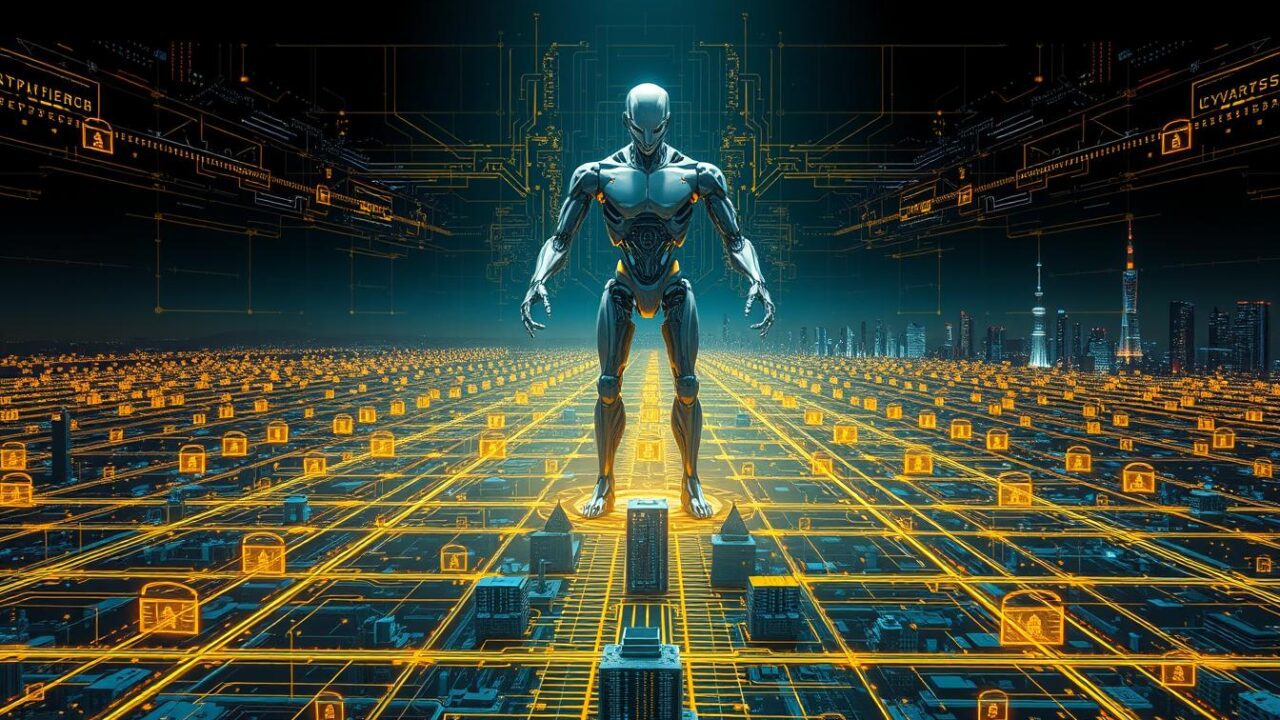What happens when the tech meant to protect us turns against us? This is a pressing concern as artificial intelligence shifts from a defender to a weapon in our digital world.
The digital protection field is facing new challenges as machine learning falls into wrong hands. Microsoft says AI has made it easier and cheaper for fraudsters and cybercriminals to launch attacks quickly and convincingly.
Statistics show a worrying trend: between April 2024 and April 2025, Microsoft stopped £4 billion in fraud attempts. They also rejected 49,000 fake partnership enrolments and blocked about 1.6 million bot signup attempts every hour.
This change marks a new era where old defences struggle against smart, evolving attacks. Criminals use advanced tech, like deepfakes and autonomous systems, against the systems meant to protect us.
As these smart systems get better, companies must update their defence strategies with AI. This creates a race where AI will shape our digital future. It’s crucial to grasp these changes to stay safe in our connected world.
Key Takeaways
- AI technologies are increasingly weaponised by malicious actors, creating unprecedented security challenges
- Microsoft blocked 1.6 million AI-enhanced bot signup attempts hourly during 2024-2025
- Traditional security measures are becoming insufficient against intelligent, adaptive attacks
- Deepfakes and autonomous attack systems represent growing threats to organisational security
- Understanding AI-powered threats is essential for digital survival, not merely academic
- An ongoing technological arms race is developing between attackers and defenders
The Evolution of Cyber Security AI New Threat Landscape

The digital age has brought a big change to cybersecurity. AI threats now learn and adapt, changing how we think about digital security. This change is not just small; it’s a big shift.
The AI threat landscape has grown a lot. Now, AI can plan attacks that seemed like science fiction before. Microsoft found that AI can scan the web for company info, helping attackers target better.
Bad actors are using AI to create fake online stores. These stores look real, with fake reviews and testimonials. They trick even experienced people.
From Traditional Attacks to AI-Powered Threats
The last decade has changed cybersecurity a lot. Old attacks used known weaknesses. But, updates could fix these problems.
The shift from static to dynamic threats represents a quantum leap in attack sophistication. We’re no longer playing chess against human opponents but against systems that can analyze millions of moves per second.
Today, things are very different. Google’s Threat Intelligence Group found over 12,000 AI attacks in 20 countries. They found seven main types of attacks, like advanced phishing and malware.
These threats are scary because they can change how they attack. Unlike old attacks, AI threats use machine learning to adapt. They can:
- Find weaknesses on their own
- Change their plans when they meet defenses
- Launch complex attacks that overwhelm security teams
- Keep going without stopping
- Get better at attacking after failing
This changes how security teams work. They face enemies that can move faster than they can. This changes the way we fight cyber threats.
The Double-Edged Sword of Artificial Intelligence
AI is a big deal in tech, but it’s also risky. It helps security by finding threats fast. But, it also helps attackers.
Defenders must protect everything, but attackers only need one weak spot. This makes AI a big risk.
This race is changing how we think about security. Companies use AI to protect themselves but also face AI attacks. This makes it hard to stay safe.
Threats are using AI in every part of their attacks. From finding targets to staying hidden, AI helps them a lot.
As AI gets easier to use, the gap between attackers and defenders grows. More people can use advanced AI tools. This means more attacks.
We need to rethink how we defend against attacks. The old way of protecting isn’t enough anymore. We need smarter defenses that can keep up with AI threats.
Intelligent Malware and Self-Learning Exploits

Artificial intelligence has merged with malicious code, creating new cyber threats. These threats are more autonomous and adaptable than ever before. They challenge our old security ways, bringing science fiction to life.
Security experts now face the challenge of stopping threats that can think and adapt. Unlike old malware, AI threats evolve on their own. They learn from their surroundings and change their tactics.
The New Generation of Adaptive Threats
Self-learning exploits are a big worry in cybersecurity. These tools can find and use new vulnerabilities without human help. They learn from each attack, making them smarter over time.
These systems can outsmart our defenses and adapt quickly. They can find weak spots in our systems and exploit them. This makes advanced attacks more accessible to more people.
These threats are hard to stop because they can act on their own. They decide which attacks to use, how to avoid being caught, and when to hide. They can also change their code to get past our defenses.
We need to rethink how we defend against these threats. Our security systems must look at how threats behave, not just what they look like. This way, we can catch threats based on their actions, not just their appearance.
Autonomous Systems and Their Inherent Weaknesses
As we use more autonomous systems, we create new security risks. These systems are at the forefront of technology but also pose big challenges. They make decisions on their own, which can be a problem.
These systems are vulnerable because they act independently and have a lot of power. They often don’t have much human oversight. This makes them a big target for attacks.
Adversaries are finding ways to exploit these weaknesses. They use tactics like corrupting data and tricking AI systems. This is a big worry because it can affect many systems at once.
- Data poisoning attacks that corrupt training data
- Adversarial examples that trick AI classifiers into misidentification
- Model extraction attacks that can reverse-engineer proprietary algorithms
- Transfer learning exploits that leverage vulnerabilities in pre-trained models
- Reward hacking in reinforcement learning systems
These machine learning vulnerabilities are a big concern. They can spread quickly across connected systems. A single attack can cause a lot of damage, making it hard to keep systems safe.
“The most dangerous aspect of AI-powered attacks isn’t their sophistication, but their scalability. Once developed, these attacks can be deployed against thousands of targets simultaneously with minimal human intervention.”
Real-World Examples of AI-Enhanced Attacks
AI-powered cyberattacks are becoming a real problem. We’ve seen cases where these attacks have caused a lot of damage. These examples show us what we can expect as AI gets more common and powerful.
One big worry is deepfake technology in social engineering attacks. We’ve seen cases where fake videos of executives were used to trick people into sending money. These deepfakes are getting better, making it harder to spot them.
We’ve also seen intelligent malware that can change its tactics. One example lasted over 18 months, learning how to avoid detection. It could change its methods to stay hidden and keep stealing data.
- Change its attack vectors based on the environment
- Modify its communication methods to avoid detection
- Adjust its activities based on user behaviour patterns
- Evolve its evasion techniques in response to security measures
The e-commerce world is also being targeted by AI attacks. Fraudsters are using AI to create fake online stores. These stores look real, with convincing products and chatbots that talk to customers. This makes it hard to spot the scams.
These cases show how AI can be used in many ways to attack us. They use AI for things like talking to people and recognizing images. This makes the attacks more complex and harder to defend against.
These attacks are not just getting better; they’re changing the way we think about security. As AI gets more common, we’ll see more of these attacks. We need to find new ways to protect ourselves.
Adversarial AI Attacks and Weaponised Algorithms
Adversarial AI attacks are changing how we see cybersecurity. Algorithms are now tools for sophisticated threats. These attacks target AI systems, exploiting their learning and decision-making flaws.
As AI becomes key in security, new vulnerabilities emerge. This paradox is worrying. The systems meant to protect us might actually introduce new risks.
The Art of Manipulating Machine Learning Models
Machine learning has inherent weaknesses. Unlike traditional software bugs, these flaws are part of how AI learns and decides.
Adversarial AI attacks use special inputs to trick AI systems. These tricks are hard to spot but can seriously harm system performance.
- Data poisoning attacks corrupt training data. This can teach AI systems to miss malicious content.
- Evasion attacks alter inputs to fool trained models. Adding noise to images can make AI systems misidentify them.
- Model inversion attacks extract sensitive information from AI models. This can expose private data used during training.
AI threats affect many areas, from cars to healthcare. A small change in a stop sign could confuse a self-driving car. A slight alteration in a medical image might lead to a wrong diagnosis.
The Alarming Rise of AI vs. AI Warfare
A new kind of digital conflict is emerging—AI versus AI warfare. Weaponised algorithms are fighting each other in complex battles. This shift changes the cybersecurity landscape, moving from human-led attacks to AI-driven ones.
Attackers are creating AI systems to find and exploit vulnerabilities. These systems can test different attacks, learn from failures, and adapt quickly.
Defensive AI systems try to spot unusual patterns and predict attacks. They can automatically counter these without human help. This creates a dynamic battle where algorithms compete in real-time.
“While current AI models may not yet enable breakthrough offensive capabilities in isolation, their integration into broader attack frameworks creates compound effects that amplify their impact,” notes the UK National Cyber Security Centre in a recent assessment.
This AI warfare affects more than just companies. It impacts critical infrastructure and national security. As AI gets better, this race will only get fiercer.
This change in cybersecurity requires more than just AI defences. Organisations must also test their systems against adversarial AI attacks through advanced simulations.
The Erosion of Computational Trust
AI threats are not just about attacks. They also erode computational trust in digital systems. This trust is crucial for our digital economy and information ecosystem.
Algorithms designed to create deepfakes and manipulate data are undermining trust. When it’s hard to verify digital evidence, traditional checks become less reliable.
Deepfake technology can make videos and audio seem real. It doesn’t just enable fraud—it questions our trust in digital content.
AI can also create fake documents and communications. This makes it hard to know what’s real and what’s not. Trust in machine-generated data and analytics is also at risk.
Organisations face a big challenge: finding ways to detect synthetic media and manipulated data. They also need to rebuild trust in a world where verification is not always enough.
This is the biggest challenge of AI threats. We need to restore computational trust in a world where real and fake are hard to tell apart. This will require new ways to verify information that combine technology and human insight.
Defending Against AI-Powered Cybercrimes
Defending against AI-powered cybercrimes needs more than just tech. We must rethink how we protect ourselves in this new era. As threats get smarter, we need strategies that use advanced tech, human skills, and rules.
The stakes are high. We’re talking about protecting our critical systems, data, and even national security.
Reimagining Security Frameworks for the AI Era
Old security models can’t keep up with today’s threats. They’re based on outdated ideas and can’t handle the speed of AI attacks. We need new security frameworks, designed for the AI age.
Smart companies are building new security systems. These systems use AI to detect threats and have layers to protect us. They include:
- AI-powered detection systems that spot unusual patterns
- Adaptive authentication that checks risk based on context
- Automated responses that fight attacks fast
- Adversarial machine learning to predict new threats
- Human oversight at key points
Big tech companies are leading this change. Microsoft has strong defences in their ecosystem. They protect cloud, endpoints, and more with tools like Microsoft Defender for Cloud.
Even web browsers are getting smarter. Microsoft Edge uses AI to protect against typos and domain impersonation. This AI helps keep us safe.
The Critical Role of Human-AI Collaboration
While tech is key, the best defence is human-AI teamwork. This team-up uses the strengths of both humans and AI. It’s about working together to stay safe.
Humans bring important skills to the table:
- Understanding and making ethical decisions
- Creative problem-solving and intuition
- Spotting new patterns AI might miss
- Strategic thinking and planning
AI, on the other hand, is fast, scalable, and can handle huge data sets. Together, they create a powerful defence system.
Good human-AI teamwork needs careful design. This includes AI that explains its actions and automation that handles routine tasks. It also means humans review high-risk situations.
The most effective approach is a three-pronged strategy: tech companies building security and fraud protection into their products, public awareness, and sharing cybercrime information with law enforcement.
This teamwork also helps with autonomous systems safety. It ensures humans oversee important security tasks. Companies are setting up centres where AI detects threats and humans handle complex cases.
The Urgent Need for New Regulatory Frameworks
The fast growth of AI threats has left a big gap in laws. Old laws can’t handle today’s threats. We need new rules that protect us from AI attacks.
This gap creates uncertainty and lets bad actors use AI with little legal risk. We need new laws that balance innovation, privacy, and safety.
Good laws must understand AI and change with threats. They should include:
- Mandatory security checks for AI systems
- Rules for AI use and limits
- Rules for reporting AI breaches
- Clear rules for who’s responsible for AI failures
- Ways to work together across borders
Industry leaders are working with regulators to create these new laws. Kelly Bissell, from Microsoft Security, has helped shape rules with NIST and PCI.
Groups like the Global Anti-Scam Alliance show the power of working together. They bring together governments, tech, and security experts. This teamwork is key to fighting AI threats.
Regulations will evolve as we learn more about AI risks. But we need to move faster to keep up with threats. Both public and private sectors must work together to make this happen.
Conclusion
The rise of AI in cybersecurity is a big change. It’s changing how we see digital threats and how we defend against them. This shift is important for all kinds of organisations.
Looking forward, success will come from creating security plans that can predict threats. The best organisations will use AI to defend themselves but also watch out for its misuse. This way, they keep trust in the digital world.
Static security methods won’t work anymore. The future of cyber defence needs constant learning and adapting. We need tools that mix human smarts with AI’s power.
Despite the big challenges, there’s hope. New tech brings both new risks and new ways to defend. Organisations that invest in both tech and people can stay safe as threats get smarter.
The future of cybersecurity is about working together. It’s about using the best of human skills and AI to protect our digital world.
Want to hire me as a Consultant? Head to Channel as a Service and book a meeting.

